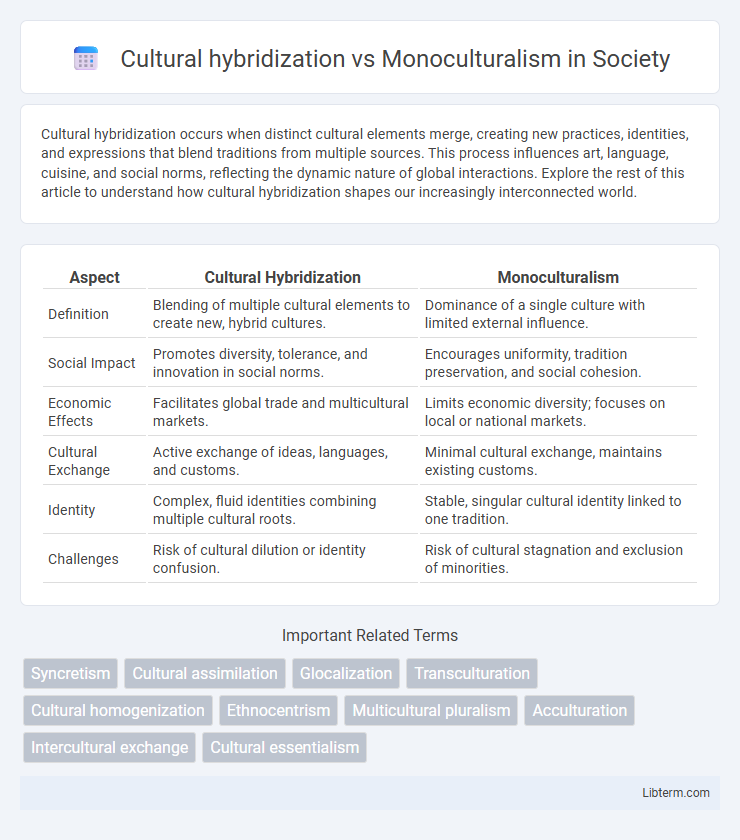Cultural hybridization occurs when distinct cultural elements merge, creating new practices, identities, and expressions that blend traditions from multiple sources. This process influences art, language, cuisine, and social norms, reflecting the dynamic nature of global interactions. Explore the rest of this article to understand how cultural hybridization shapes our increasingly interconnected world.
Table of Comparison
| Aspect | Cultural Hybridization | Monoculturalism |
|---|---|---|
| Definition | Blending of multiple cultural elements to create new, hybrid cultures. | Dominance of a single culture with limited external influence. |
| Social Impact | Promotes diversity, tolerance, and innovation in social norms. | Encourages uniformity, tradition preservation, and social cohesion. |
| Economic Effects | Facilitates global trade and multicultural markets. | Limits economic diversity; focuses on local or national markets. |
| Cultural Exchange | Active exchange of ideas, languages, and customs. | Minimal cultural exchange, maintains existing customs. |
| Identity | Complex, fluid identities combining multiple cultural roots. | Stable, singular cultural identity linked to one tradition. |
| Challenges | Risk of cultural dilution or identity confusion. | Risk of cultural stagnation and exclusion of minorities. |
Understanding Cultural Hybridization
Cultural hybridization refers to the dynamic process where distinct cultural elements blend to create new, hybrid forms that reflect diverse social influences. This phenomenon fosters intercultural dialogue and innovation, contrasting sharply with monoculturalism, which emphasizes homogeneity and the preservation of a single cultural identity. Understanding cultural hybridization is essential for analyzing globalization's impact on cultural identities and societal change.
Defining Monoculturalism
Monoculturalism refers to the preservation or dominance of a single, homogeneous culture within a society, often characterized by uniform traditions, language, and social norms. This cultural framework limits diversity and tends to resist external influences, maintaining a stable but static cultural identity. In contrast to cultural hybridization, which embraces the blending and interaction of multiple cultural elements, monoculturalism fosters cultural exclusivity and continuity.
Historical Roots of Cultural Hybridization
Cultural hybridization traces its historical roots to periods of extensive trade, colonization, and migration, where diverse societies interacted and exchanged ideas, customs, and technologies. Ancient trade routes like the Silk Road facilitated the blending of cultural practices across Asia, Europe, and Africa, producing hybrid art, language, and religious beliefs. In contrast, monoculturalism emphasizes the preservation of a single, dominant culture, often resisting external influences and limiting the dynamic cultural exchanges inherent in hybridization.
The Appeal of Monocultural Societies
Monocultural societies often appeal due to their strong sense of identity, unified social norms, and cultural continuity, which foster community cohesion and stability. These societies emphasize shared traditions, language, and values that simplify social interactions and reduce cultural conflicts. The predictability of a monocultural environment can enhance social trust and collective belonging, attracting those seeking clarity and order in cultural expression.
Drivers of Cultural Blending in the Modern World
Globalization, technological advancements, and increased migration serve as primary drivers of cultural hybridization by facilitating the exchange of ideas, customs, and traditions across borders. Social media platforms and international commerce accelerate this cultural blending, fostering hybrid identities and mixed cultural expressions. In contrast, monoculturalism often arises from nationalist policies and efforts to preserve homogeneity, which resist these dynamic interactions and promote cultural uniformity.
Benefits of Embracing Hybrid Cultures
Embracing cultural hybridization fosters innovation by blending diverse traditions, leading to enriched creativity in arts, cuisine, and technology. Hybrid cultures promote social inclusivity and global understanding, reducing ethnocentric biases and enhancing cooperation across communities. This dynamic cultural exchange also boosts economic growth by expanding markets and driving demand for multicultural products and services.
Challenges and Criticisms of Monoculturalism
Monoculturalism faces challenges such as social exclusion, reduced innovation, and limited adaptability due to its emphasis on cultural uniformity. Critics argue it fosters ethnocentrism, suppresses minority identities, and undermines multicultural understanding in increasingly globalized societies. These limitations highlight the growing necessity for cultural hybridization as a more inclusive and dynamic social model.
Globalization’s Impact on Cultural Identity
Globalization accelerates cultural hybridization by blending diverse traditions, languages, and customs, creating dynamic new identities that transcend geographical boundaries. Monoculturalism, prioritizing a single cultural narrative, risks cultural stagnation and loss of pluralistic cultural wealth within global societies. The tension between hybridization and monoculturalism highlights how global interconnectedness reshapes cultural identity through both integration and resistance.
Case Studies: Hybrid vs. Monocultural Societies
Case studies of cultural hybridization reveal dynamic societies like Singapore, where multilingual policies and diverse ethnic groups coexist, fostering innovation and social cohesion. In contrast, monocultural societies such as Japan emphasize cultural homogeneity, which can strengthen national identity but may limit adaptability to global influences. Hybrid societies demonstrate increased cultural resilience and economic flexibility compared to the more rigid social structures observed in monocultural environments.
The Future: Toward Coexistence or Cultural Dominance?
Cultural hybridization fosters dynamic exchanges blending traditions, languages, and identities, creating diverse, adaptive societies that resist monocultural dominance. The future hinges on balancing multicultural coexistence, where pluralism and mutual respect thrive, against forces pushing for cultural homogenization driven by globalization and political agendas. Sustainable cultural policies must promote inclusivity, protect minority heritage, and leverage digital connectivity to amplify diverse voices, ensuring a pluralistic global society rather than a monocultural world.
Cultural hybridization Infographic

 libterm.com
libterm.com